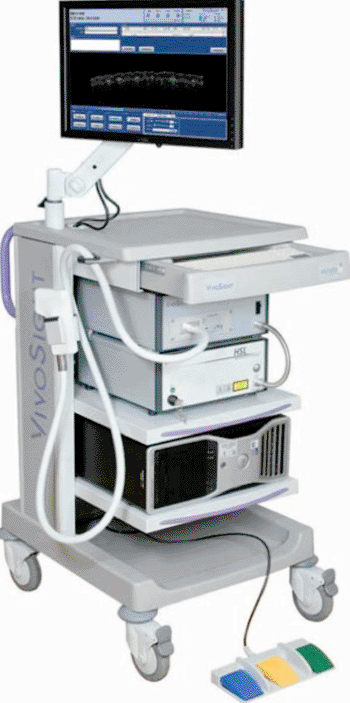OCT Scanner Helps Diagnose Skin Cancers
By MedImaging International staff writers
Posted on 04 Jul 2013
A novel skin scanning device helps dermatologists diagnose, treat, and monitor a range of commonly occurring skin cancers and other conditions.Posted on 04 Jul 2013
The VivoSight OCT scanner is an advanced laser-based technology that produces high definition images of the skin up to a depth of 2 mm, using a lightweight maneuverable probe that is placed against the skin to produce the real time images. Using the generated images, dermatologists can immediately confirm the clinical diagnosis and severity of basal cell carcinoma (BCC), distinguish between a superficial actinic keratosis (AK) and a more invasive squamous cell carcinoma (SCC), and diagnose and follow treatment of nychomycosis, psoriasis and psoriatic arthritis, scleroderma, and oral cancer.

Image: The VivoSight OCT scanner (Photo courtesy of Michelson Diagnostics).
The VivoSight OCT scanner is based on Optical Coherence Tomography (OCT) technology, an optical signal acquisition and processing method that captures micrometer-resolution, three-dimensional (3D) images from within biological tissue. The probe is positioned over the tissue and can capture either 2 or 3 dimensional (2D, 3D) images of a 5 mm square region. Tissue microstructure features such as epidermis, dermis, and sub-layers can be viewed, as can subsurface blood vessels. The VivoSight OCT scanner is a product of Michelson Diagnostics (Orpington, United Kingdom).
“Dermatology today is like dentistry was before the X-ray. They look at the skin on the surface to try and guess what’s going on underneath. Often they have to take a biopsy – it’s like pulling teeth to find out if they’re rotten,” said Jon Holmes, CEO of Michelson Diagnostics, in a recent interview in The Telegraph. “There’s real potential for a scanner to pick things up earlier, enable the right treatment to be used and monitored and make sure you’ve got it all out in one go.”
“High-resolution imaging with a multibeam OCT device can accurately predict tumor margins of a BCC prior to Mohs micrographic surgery,” said dermatologist Stanley Chan MD, of Boston College (MA, USA). “The VivoSight OCT device was able to effectively depict the tumor extension. With any tumor, particularly ill-defined ones, the use of OCT could potentially reduce the number of stages required to clear the tumor leading to shorter operative times and reduction of cost.”
OCT is an interferometric technique, typically employing near-infrared (nIR) light, a relatively long wavelength light that allows it to penetrate into the scattering medium.
Related Links:
Michelson Diagnostics














